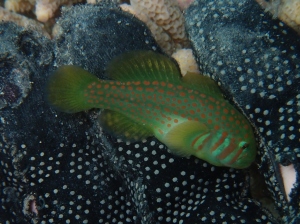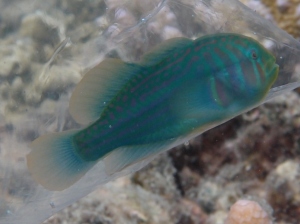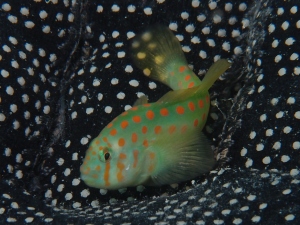I thought it might be a good idea to start a collection of goby pics. I didn’t take enough last time I was out in the field so stay tuned for the remaining species. But here a few to get started on. Apologies for the ones in plastic bags. That’s just how we collect them. Next time I’ll try to take more photos of them in their corals, although that gets pretty tricky as they rarely come out onto the branches.
First up, meet Gobiodon erythrospilus. AKA “Spots”. These ones can be found on just about any reef with acroporid corals on it. Very closely related to G. histrio. In fact, they were previously thought to be variants of the same species. On Lizard island we were mostly finding these in A. tenuis, A. millepora and A. nasuta. Usually they are found as a pair of monogamous breeders, but occasionally we found them with one or two juveniles inhabiting the same coral.
Next is the closely related Gobiodon histrio. AKA “Stripes”. Both Stripes and Spots have the vertical red bars on the face, but Stripes (as you might have guessed) has horizontal stripes along the body. Stripes was almost exclusively seen as pairs or on its own during our last trip, with only one exception. Although it has been observed occasionally in larger groups on previous trips. My research is all about why animals form groups, so to see a usually asocial species forming groups of up to four individuals is quite exciting. Later trips will focus on measuring ecological differences between these colonies.
You could be forgiven for making the assumption that our next contender was closely related to Spots and Stripes. Well, since they’re all from the same genus, you wouldn’t be far off. However, G. sp A, AKA ‘Measles’ (so recently described that it hasn’t been properly named yet!) is actually more closely related to G. brochus, an olive green species with no spots or distinct markings (stay tuned for a pic!). Measles has larger spots than G. erythrospilus and lacks the thick red bars on the face. Although the individual below has several confusing spots blurring into bars on the face. A hybrid perhaps? Measles was much less abundant at Lizard island than either of the previous species but did turn up at a number of different locations.
Goby Trivia
Coral gobies eat toxic algae which they can convert into their own skin toxin. Don’t lick them!
Dixson, D. L. and M. E. Hay (2012). “Corals Chemically Cue Mutualistic Fishes to Remove Competing Seaweeds.” Science 338 (6108): 804-807.
If you’d like to know more about coral gobies or my research, just drop me a line below.
In the next issue of GobyPro
Oranges and Lemons! (aka G. citrinus and G. okinawae).
Contact Form



